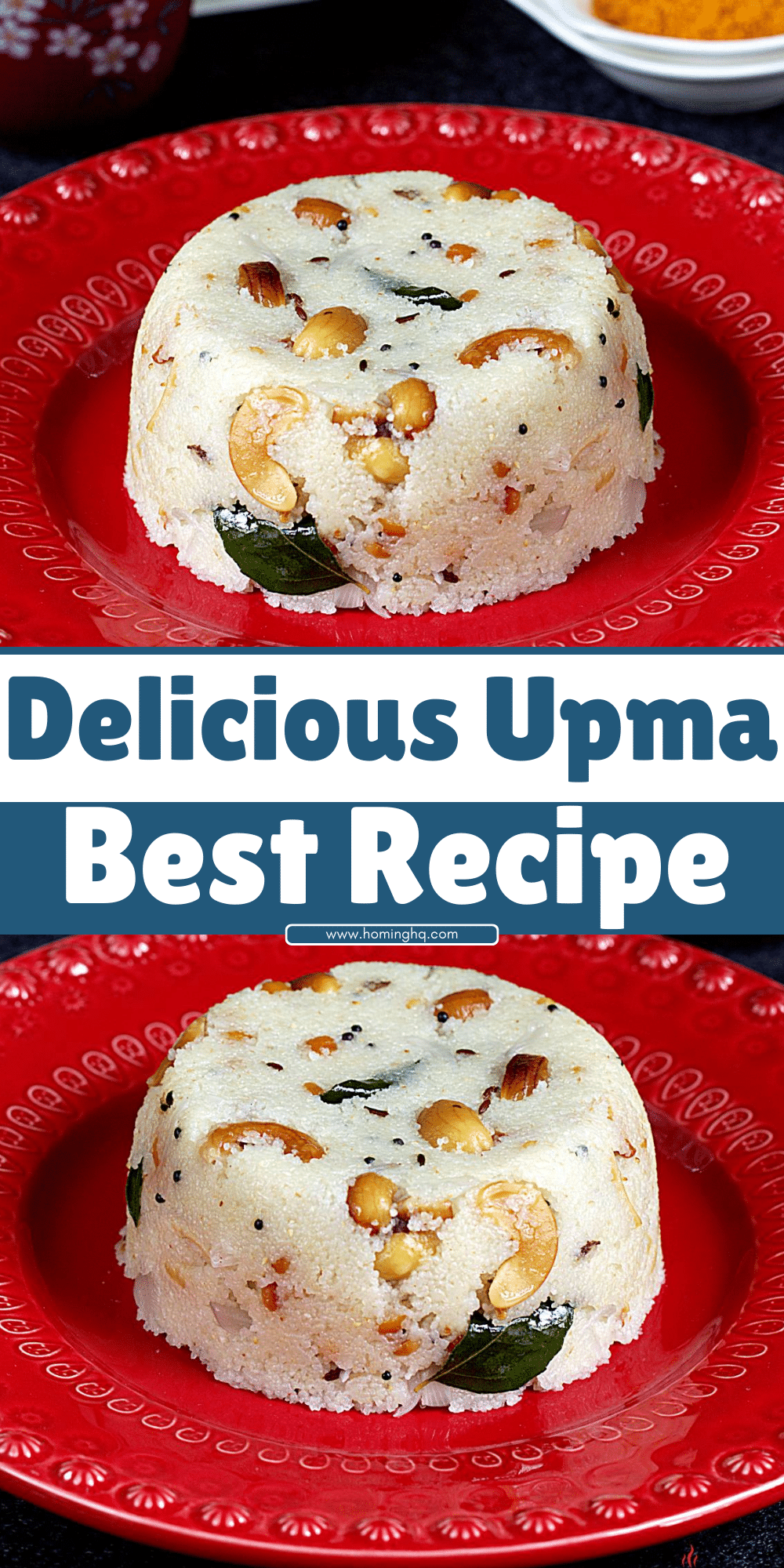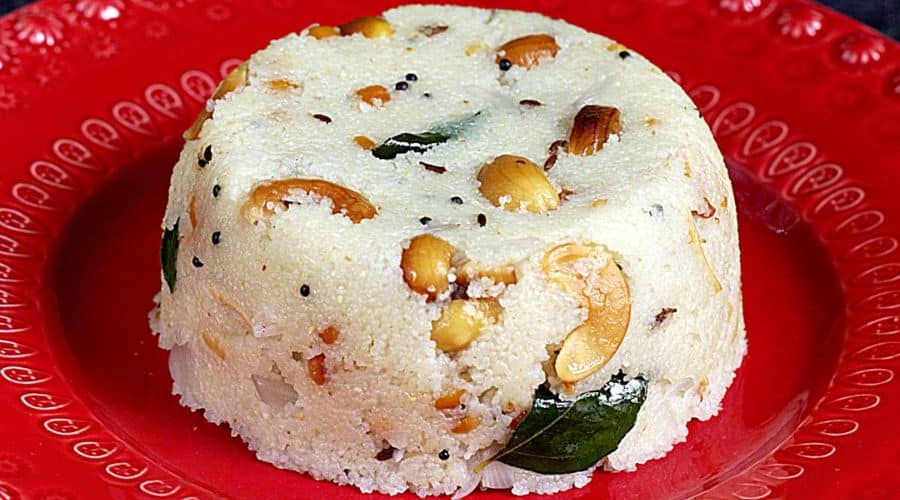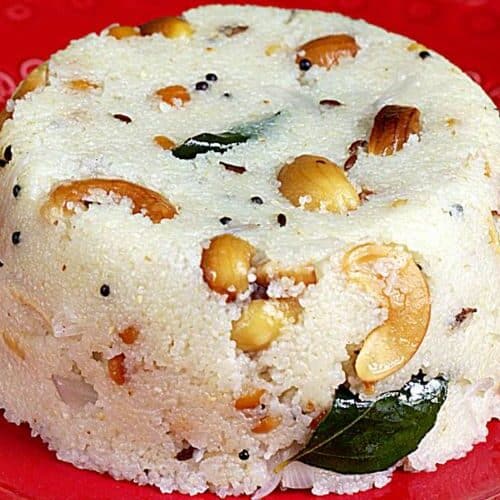All products are selected by our editorial team for quality. If you buy through our links, we may earn a small commission at no extra cost to you.
Upma is an iconic South Indian breakfast dish loved for its simplicity, nutritional value, and versatility.
Made primarily from semolina (rava) and a variety of spices, it’s a comfort food that’s easy to prepare and packed with flavors.
Traditionally, upma is enjoyed with a side of coconut chutney or sambar, enhancing its taste and making it even more fulfilling.
While upma is typically served as a breakfast dish, it can also be enjoyed as a light lunch or dinner.
It is an excellent option for those looking for a meal that’s quick to prepare yet nourishing, providing a balance of carbohydrates, fiber, and healthy fats.
Whether you’re cooking for yourself or for a group, upma can be customized with different vegetables and nuts, making it a versatile and delightful meal.

What is Upma?
Upma is a savory dish made from semolina (rava), a coarse wheat flour.
It’s a staple in South Indian homes and has gained popularity across India and beyond for its delicious taste and ease of preparation.
While the base of upma remains semolina, it can be customized in countless ways by adding vegetables, nuts, and spices, allowing for a wide range of flavor profiles.
The dish is usually made by sautéing semolina in ghee or oil with a mix of mustard seeds, cumin, curry leaves, and other aromatic spices, followed by the addition of vegetables like onions, carrots, peas, and beans.
The semolina is then cooked with water or stock to create a soft, fluffy texture.
Upma is known for its comforting warmth and nutritional balance, making it an ideal start to the day.
Key Ingredients for Upma
To make a classic upma, you’ll need a handful of key ingredients. Each plays a significant role in contributing to the flavor and texture of the dish.
Semolina (Rava)
The main ingredient in upma, semolina, gives the dish its characteristic texture.
It’s best to use medium or fine rava for a smooth, fluffy consistency.
Semolina can be found in most grocery stores and is a versatile ingredient used in a variety of dishes across different cuisines.
Vegetables
Upma can be made with a variety of vegetables. Common choices include:
- Carrots (chopped into small cubes)
- Peas
- Beans
- Onions (finely chopped) These vegetables not only add color and flavor but also provide additional nutrients and fiber, making upma a well-rounded meal.
Spices and Seasonings
Spices are what give upma its distinctive taste. Key spices include:
- Mustard seeds
- Cumin seeds
- Curry leaves
- Green chilies A pinch of salt and a dash of asafoetida (hing) can further enhance the flavor.
Ghee or Oil
Upma is traditionally made with ghee, which adds a rich, aromatic flavor to the dish.
However, you can also use oil if you prefer a lighter option. Both give the upma a luscious texture and help in tempering the spices.
Cashews and Urad Dal (Optional)
For added crunch and flavor, you can include cashews and urad dal (split black gram).
These ingredients provide a satisfying texture contrast and are commonly used in traditional upma recipes.
Step-by-Step Guide to Making Upma

Follow this simple step-by-step guide to make the perfect upma that is fluffy, flavorful, and satisfying.
Step 1: Roasting the Semolina
The first step is to dry roast the semolina in a pan over medium heat.
Stir constantly for 4-5 minutes, ensuring the rava doesn’t burn. Roasting it evenly brings out its nutty flavor and prevents the upma from becoming sticky.
Once it turns slightly golden and aromatic, remove it from the pan and set aside.
Step 2: Preparing the Tempering
In the same pan, heat ghee or oil over medium heat. Add mustard seeds and let them splutter.
Then, add cumin seeds, chopped green chilies, and curry leaves, and sauté for a few seconds until the spices release their fragrance.
This tempering forms the base flavor of your upma.
Step 3: Cooking the Vegetables
Now, add the finely chopped vegetables such as onions, carrots, peas, and beans to the pan.
Sauté them for 3-4 minutes, allowing them to soften and absorb the spices.
You can also add a pinch of turmeric to enhance the color and flavor of the dish.
Step 4: Adding Water and Cooking the Mixture
Once the vegetables are cooked, add water (about 2 cups for every 1 cup of semolina) to the pan and bring it to a gentle boil. Season with salt to taste.
Once the water starts boiling, reduce the heat and slowly add the roasted semolina, stirring continuously to prevent lumps from forming.
Allow it to cook for about 3-5 minutes, or until the semolina absorbs all the water and becomes fluffy.
Step 5: Final Touches
After the upma reaches your desired consistency, remove it from heat and let it sit for a minute.
You can stir in a tablespoon of ghee at this point for extra flavor.
Garnish with chopped coriander leaves and serve hot with coconut chutney or sambar for a traditional South Indian experience.
Tips for Perfect Upma Every Time
Making the perfect upma requires a few simple techniques that ensure it turns out fluffy, flavorful, and not too sticky.
Here are some tips to help you get it right every time:
1. Roast the Semolina Properly
The key to a non-lumpy, fluffy upma is roasting the semolina well.
Dry roast the semolina in a pan until it turns slightly golden and releases a nutty aroma.
This step helps in preventing the upma from becoming sticky or clumpy while cooking.
2. Use the Right Water-to-Semolina Ratio
The perfect consistency of upma comes from balancing the right amount of water and semolina.
Typically, a 1:2 ratio of semolina to water works best (1 cup semolina to 2 cups water).
If you prefer a slightly drier version, reduce the water by a little. Always adjust the water depending on the type of semolina used for the best results.
3. Stir Constantly When Adding Semolina to Water
When you add the semolina to boiling water, stir continuously to avoid lumps.
Stirring helps the semolina to evenly absorb the water and cook to a soft and fluffy texture. Be patient, and don’t rush this step.
4. Add Ghee for Extra Flavor
For a richer flavor and a smoother texture, consider adding ghee instead of oil.
Ghee not only enhances the taste but also gives the upma a wonderful aroma.
If you prefer a lighter version, you can use oil, but ghee adds an authentic touch.
5. Let the Upma Rest Before Serving
Once your upma is ready, let it sit for a minute or two after cooking.
This helps the semolina absorb any remaining moisture and results in a fluffier consistency.
Give it a gentle stir before serving to ensure it’s well-mixed and airy.
Common Upma Variations
Upma is an incredibly versatile dish, and there are numerous variations you can try to suit your tastes or dietary preferences. Here are some popular variations to consider:
1. Vegetable Upma
The most common variation, vegetable upma is made by adding a variety of fresh vegetables to the semolina mixture.
Typical vegetables include carrots, peas, beans, onions, and tomatoes.
This version adds color, texture, and extra nutrition to the dish, making it a complete meal.
2. Rava Upma with Peanuts or Cashews
For a crunchy texture, you can add roasted peanuts or cashews to your upma.
These nuts are often added during the tempering phase, which brings out their flavor and provides a satisfying contrast to the soft semolina.
They also enhance the overall richness of the dish.
3. Lemon Upma
Lemon upma is a tangy and zesty variation where fresh lemon juice is added towards the end of cooking.
The acidity from the lemon balances the richness of the upma, giving it a refreshing taste.
You can also add a sprinkle of lemon zest for additional flavor.
4. Sweet Upma (Sheera)
In contrast to the savory upma, sweet upma, also known as sheera, is made with sugar, ghee, and cardamom. It’s a popular treat for breakfast or as a dessert.
To make sweet upma, replace the salt with sugar and add dry fruits like raisins and cashews for extra sweetness.
5. Semiya Upma (Vermicelli Upma)
A delightful alternative to traditional semolina upma, semiya upma is made using thin vermicelli (semiya) instead of rava.
The process is similar, with a tempering of spices followed by the addition of water.
Vermicelli gives the upma a different texture and is often used in festivals and special occasions.
6. Tomato Upma
For a tangy twist, tomato upma incorporates fresh tomatoes, which add a lovely color and slight acidity to the dish.
The tomatoes are sautéed with the tempering ingredients and cooked along with the semolina, resulting in a flavorful and vibrant upma.
7. Oats Upma
For a healthier version, you can replace semolina with oats.
Oats upma is a great alternative for those looking for a gluten-free or high-fiber option.
The preparation remains the same, but oats provide a different texture and nutritional profile while still being light and filling.
Conclusion
Upma is a simple yet delicious dish that offers a variety of textures and flavors with its ability to be customized.
Whether you’re preparing it for a busy morning breakfast, a light lunch, or even a comforting dinner, upma is a versatile and satisfying option.
The combination of semolina, spices, and vegetables creates a balanced, healthy meal that can be easily tailored to suit your taste.
By following the step-by-step guide and incorporating tips for perfecting the dish, you’ll be able to create upma that’s both fluffy and flavorful every time.
Additionally, with the numerous variations to explore, you can make upma in countless ways, adding your unique twist to this beloved dish.
Enjoy making upma at home, and don’t forget to experiment with different ingredients to make it your signature breakfast!
Frequently Asked Questions (FAQs)
1. Can I make upma in advance and store it?
Yes, upma can be made ahead of time and stored in the refrigerator for 2-3 days.
Reheat it by adding a little water or ghee to restore its moisture. It can also be packed for lunch and enjoyed cold if needed.
2. How do I make upma spicier?
To add more spice to your upma, simply increase the amount of green chilies or red chili powder during the tempering.
You can also add ginger or garlic for additional heat and flavor. For a unique twist, try incorporating black pepper.
3. Can I use other types of grains instead of semolina (rava)?
Yes, you can substitute semolina with other grains such as couscous, broken wheat, or quinoa.
These grains can give your upma a slightly different texture while maintaining the overall essence of the dish.
4. How do I avoid upma becoming too sticky or lumpy?
The key to avoiding a sticky or lumpy upma is roasting the semolina properly and stirring continuously when adding it to the boiling water.
Ensure the water-to-semolina ratio is correct, and add the semolina slowly to allow for even cooking.
5. Is upma a healthy breakfast option?
Yes, upma is a healthy and nutritious option for breakfast.
It is high in fiber and can be made even healthier by adding extra vegetables or using whole wheat rava.
Additionally, it’s a good source of energy and can be easily adjusted to meet various dietary preferences.

Upma
Equipment
- 1 Medium-sized pan or wok
- 1 Cooking spoon or spatula
- 1 Ladle
- 1 chopping board
- 1 Knife
- 1 measuring cup
Ingredients
- 1 cup Semolina Rava
- 2 tbsp Ghee or oil
- 1/2 cup Carrots finely chopped
- 1/4 cup Peas frozen or fresh
- 1/4 cup Beans chopped
- 1 medium Onion finely chopped
- 2-3 Green chilies slit
- 1 tbsp Cashews optional
- 1 tbsp Urad dal optional
- 1 tsp Mustard seeds
- 1/2 tsp Cumin seeds
- 1 sprig Curry leaves
- 2 cups Water
- Salt to taste
- 1/4 tsp Asafoetida Hing, optional
- 1 tbsp Fresh coriander leaves for garnish
Instructions
- Roast the Semolina: Heat a pan over medium heat and dry roast the semolina until it turns lightly golden and aromatic. Stir continuously to prevent burning. Remove from heat and set aside.
- Prepare the Tempering: In the same pan, heat ghee or oil. Add mustard seeds and let them splutter. Then, add cumin seeds, curry leaves, and green chilies. Sauté for a few seconds until fragrant.
- Cook the Vegetables: Add chopped onions, carrots, peas, and beans to the pan. Sauté for 3-4 minutes until the vegetables soften. You can also add a pinch of turmeric at this point for color.
- Add Water: Pour in 2 cups of water and bring to a boil. Season with salt to taste. If you like a slight tang, you can add a squeeze of lemon here.
- Add Semolina: Reduce the heat to low and slowly add the roasted semolina, stirring constantly to prevent lumps from forming. Let the mixture cook for 3-5 minutes until the semolina absorbs all the water and becomes fluffy.
- Final Touches: Once cooked, remove from heat and let it sit for a minute. Garnish with fresh coriander leaves and serve hot with coconut chutney or sambar.
Notes
- Consistency: If you prefer your upma softer, add a bit more water while cooking. If you prefer a drier version, reduce the water slightly.
- Nuts: You can add roasted peanuts or cashews for extra crunch and flavor.
- Vegetable Variations: Feel free to add other vegetables like potatoes, beans, or bell peppers based on your preference.
- Gluten-Free Version: Replace semolina with oats or quinoa for a gluten-free version of upma.
- Spice Level: Adjust the number of green chilies based on your spice tolerance.

